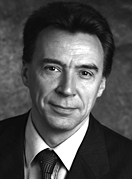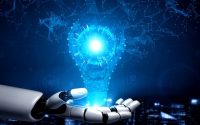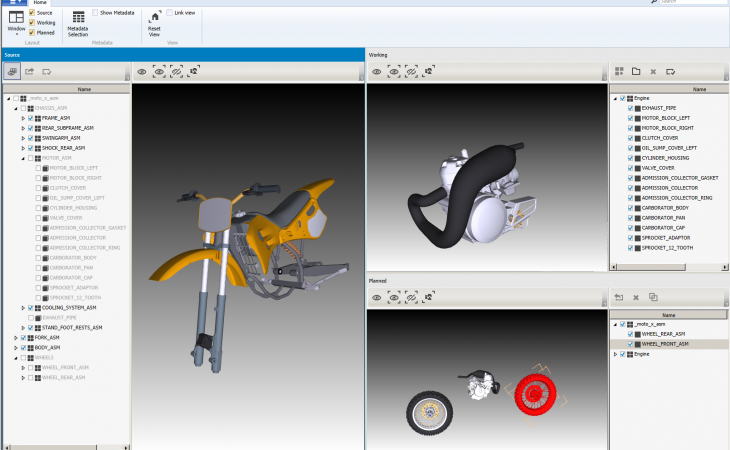
There’s good news to report on SAP Visual Enterprise. The vendor is making progress in the integration of the visualization suite in its ERP and PLM offering and successively developing new application scenarios as revealed in a background discussion with Dr Stephan Kohlhoff from the Enterprise Solution Management of SAP AG. “The idea is to enrich the mapping of BOM structures between different disciplines with a visualization component,” the visualization specialist explains. The handover of the bill of material (BOM), let’s say from design to production, is now supported graphically in order to capture the different contexts faster. “The structures are often not identical, perhaps because only a specific configuration was designed initially, in the engineering BOM (EBOM), however, all configurations should be included,” Dr Kohlhoff explains. Corresponding functions to convert such BOM structures are provided in the SAP user interface. And the result is visualized accordingly. “The advantage is that the transfer is prone to fewer errors because changes are immediately apparent. Often, several hundred up to a thousand components have to be processed. Here, SAP Visual Enterprise technology helps to hand over BOMs even for very large structures,” Dr Kohlhoff says.
The visualization expert sees the next step in supporting additional types of handover, not just the transition of data from design to fabrication, e.g. the transformation of EBOMs into service structures too. “In principle this can be any type of SAP BOM or any kind of business object hierarchy, such as a functional location hierarchy.” In the simplest case these are serialized parts and materials together in a loose or predefined composite. The goal is, Dr Kohlhoff says, to respond intuitively with a configurable front-end to different requirements in order to connect SAP standard objects with each other in the back-end.
 To illustrate the added value of that, Dr Kohlhoff once again cites the example of the transfer of an engineering BOM into a production BOM. Basically, there are two ways to think about the steps in which a product can be fabricated. In a motorcycle, for example, first the engine must be fitted. For this purpose, the relevant 3D information is selected in the engineering BOM and copied into the new bill of material. Under certain circumstances, the assembly BOM may differ from the EBOM, for example, because certain components are pre-assembled prior to installation, Dr Kohlhoff says that “certain source structures are consumed graphically.” A wheel, for example, may be designed in detail with all parts, but will be assembled as a whole because it is delivered by a supplier. So SAP provides the possibility to cut these parts out of the BOM. Graphically, you have to think of this as a challenge, because the corresponding items must be combined into a merged 3D model – SAP refers to this procedure as “graphically collapsing”.
To illustrate the added value of that, Dr Kohlhoff once again cites the example of the transfer of an engineering BOM into a production BOM. Basically, there are two ways to think about the steps in which a product can be fabricated. In a motorcycle, for example, first the engine must be fitted. For this purpose, the relevant 3D information is selected in the engineering BOM and copied into the new bill of material. Under certain circumstances, the assembly BOM may differ from the EBOM, for example, because certain components are pre-assembled prior to installation, Dr Kohlhoff says that “certain source structures are consumed graphically.” A wheel, for example, may be designed in detail with all parts, but will be assembled as a whole because it is delivered by a supplier. So SAP provides the possibility to cut these parts out of the BOM. Graphically, you have to think of this as a challenge, because the corresponding items must be combined into a merged 3D model – SAP refers to this procedure as “graphically collapsing”.
Another method for the data transfer ensues when you first look at disassembly and then simply turn around the resulting sequence. It is only necessary to take into account that the disassembled parts must be stored in appropriate containers, which are represented by operations in work plans within the ERP data model. Thus the result is a direct allocation of the EBOM for an assembly sequence, only parts and material numbers have to be assigned.
In this context Dr Kohlhoff talks of the semantic linking of different disciplines: “In a first step the front-end is application agnostic. With our visualization technology, the components signal the user, however, that they are not just an abstract BOM item, but that they include a number of instances, all of which have a specific position in space.”
The material of a BOM item is not one to one, it includes certain amounts of parts which, in turn, relate to instances and location information. These correlations can be made visible with a user-specific expressed semantic model.
Bottleneck availability of 3D content
Getting access to 3D data is still sometimes a significant problem, because it is often simply not available. Suppliers, for example, may be reluctant to provide it because they associate it with intellectual property: “We try to offer support here by providing our users with the possibility to work with incomplete 3D information.” So even non-visual parts can be included in the handover. SAP also offers a new solution with the possibility of tagging drawings in order to link them with ERP objects. Dr Kohlhoff sums up: “Here SAP too is called on to convince clients that 3D data should be made available over the entire value chain. But we are confident that our clients will listen to us because the efficiency gains are really tremendous.”
BERNHARD D. VALNION











